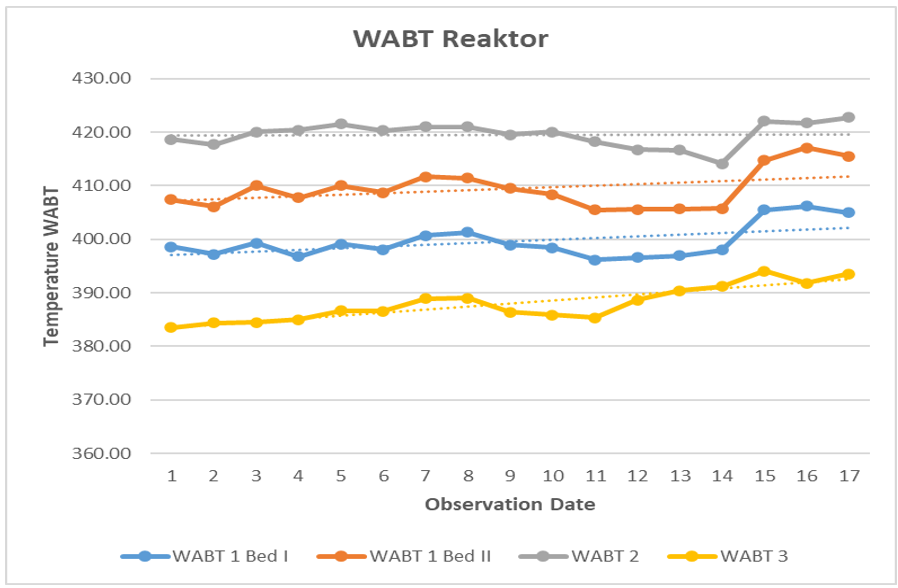Optimizing Catalyst Loading for Improved Quality of SF-05 in Hydrocracker Reactor C-3-03B at HCU RU V Balikpapan
DOI:
https://doi.org/10.26555/ijce.v3i1.873Keywords:
Catalyst, Hydrocracking, Hydrogen, Smooth Fluid, ReactorAbstract
PT Kilang Pertamina Internasional RU V Balikpapan innovated the Unibon Hydrocracker unit to increase the production of Smooth Fluid (SF-05), a high-quality base oil for drilling mud. Because the catalyst was approaching the end of run and the product did not yet meet specifications, the catalyst (Change of Catalyst - COC) was replaced with a new configuration in Reactor I C-3-03B. This research aims to optimize the hydrocracking process by changing catalyst loading and operating settings for the C-3-16B fractionation column. It is hoped that this effort will produce high-quality SF-05, meet market demand, and increase efficiency and environmental friendliness. The research results show that the Smooth Fluid SF-05 product meets all specifications with an average hydrogen consumption of 231,649 Nm3/m3 (purity 94.83%) in the HCU Train B reactor. This condition helps improve the quality of products that are more competitive in the market, thus having a positive impact on increasing company profits. Hydrogen consumption is influenced by various process variables and increases with changes in hydrogen partial pressure, CFR, H2/HC ratio, conversion rate, WABT, and LHSV. All process variables are still within the specified operating design range.
References
[1] S. Raseev, Thermal and Catalytic Processes in Petroleum Refining. 2003. doi: 10.1201/9780203912300.ax1.
[2] R. Saab, K. Polychronopoulou, L. Zheng, S. Kumar, and A. Schiffer, “Synthesis and performance evaluation of hydrocracking catalysts: A review,” J. Ind. Eng. Chem., vol. 89, pp. 83–103, 2020, doi: 10.1016/j.jiec.2020.06.022.
[3] H. H. Pham et al., “Hydrocracking and hydrotreating reaction kinetics of heavy oil in CSTR using a dispersed catalyst,” J. Pet. Sci. Eng., vol. 197, no. September, p. 107997, 2021, doi: 10.1016/j.petrol.2020.107997.
[4] A. Alvarez-Majmutov and J. Chen, “Modeling and simulation of a multibed industrial hydrotreater with vapor-liquid equilibrium,” Ind. Eng. Chem. Res., vol. 53, no. 26, pp. 10566–10575, 2014, doi: 10.1021/ie501032j.
[5] P. L. M. Wisata, “Company Profile Company Profile,” CompanyProfile, no. 16, pp. 8–9, 2019, [Online]. Available: https://www.usf.edu/business/documents/departments/finance/smif/analysis-baba.pdf%0Ahttps://stories.starbucks.com/uploads/2019/01/AboutUs-Company-Profile-1.6.21-FINAL.pdf
[6] A. R. Rangga Wastu, R. Husla, L. Zabidi, and A. Hamid, “Studi Laboratorium Penggunaan Lumpur Smooth Fluid 05 Dan Saraline Pada Temperatur Tinggi,” PETROJurnal Ilm. Tek. Perminyakan, vol. 9, no. 4, pp. 174–183, 2020, doi: 10.25105/petro.v9i4.8171.
[7] J. G. S. Jorge Ancheyta, “(Chemical Industries) Jorge Ancheyta, James G. Speight - Hydroprocessing of Heavy Oils and Residua (Chemical Industries) -CRC Press (2007).pdf,” 2007.
[8] R. Bandyopadhyay, O. F. Alkilde, I. Menjon, L. H. Meyland, and I. V. Sahlertz, “Statistical analysis of variation of economic parameters affecting different configurations of diesel hydrotreating unit,” Energy, vol. 183, pp. 702–715, 2019, doi: 10.1016/j.energy.2019.06.156.
[9] Q. Xin, A. Alvarez-Majmutov, H. D. Dettman, and J. Chen, “Hydrogenation of Olefins in Bitumen-Derived Naphtha over a Commercial Hydrotreating Catalyst,” Energy and Fuels, vol. 32, no. 5, pp. 6167–6175, 2018, doi: 10.1021/acs.energyfuels.8b00344.
[10] A. Alvarez-Majmutov, R. Gieleciak, and J. Chen, “Modeling the molecular composition of vacuum residue from oil sand bitumen,” Fuel, vol. 241, no. January 2018, pp. 744–752, 2019, doi: 10.1016/j.fuel.2018.12.096.

Downloads
Published
Issue
Section
License
Copyright (c) 2025 Adi Sampurno, Totok Eka Suharto, Zahrul Mufrodi

This work is licensed under a Creative Commons Attribution-ShareAlike 4.0 International License.



